Braiding Instructions
NOTE: We have given directions below for making two large challot. However, the recipe can easily be divided into four portions to make four medium-size challot. If making four challot, roll the strands (for braiding) 1 to 2 inches shorter than indicated below.
THREE-STRAND BRAID
1 For each challah, divide one dough portion into three equal pieces. Roll out each piece into a long uniform strand (about 16-inches). Place the three strands side by side lengthwise.
2 The strands will be braided from the center down and the center up. Starting at the center, take the strand on the outer right, cross it over the middle strand, and bring it into the middle.
3 Take the strand on the outer left, cross it over the middle strand and let it rest in the middle.
4 Repeat this procedure, alternately bringing the one on the outer right to the middle, and then bringing the one on the outer left to the middle, to the bottom.
5 Reverse the loaf so the free ends point downward and finish braiding in the same manner.
6 At each end, pinch the individual strand ends together and tuck them under the braid to finish.
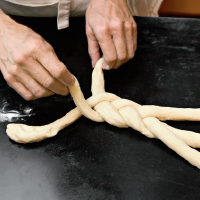
FOUR-STRAND BRAID
1 Divide one dough portion into four equal pieces. Roll out each piece into a long uniform strand (about 14-inches). Place strands side by side and pinch together the ends at the top.
2 Beginning from the left and working to the right, take the outside strand and weave it over the next strand, under the next, and over the last on the right.
3 To continue, from the left take the outside strand and weave it over the next strand, and under the next and over the last on the right.
4 Proceed as above weaving each strand over and under the other strands until the ends of the strands are reached. Pinch the ends together and tuck them under the loaf to finish.
DOUBLE BRAID
Follow the steps for a three-strand braid with slight modifications: Divide one dough portion into four equal pieces and roll out three of the pieces into long uniform strands (about 14 inches long each). Follow braiding directions for a three-strand loaf. Divide the fourth piece into three equal pieces and roll them into strands the same length as the already formed braid. These pieces will be much thinner. Make a long thin braid out of these strands. Place on top of the three-strand loaf and stretch it so you can tuck the ends under the loaf. Pinch the ends and pinch along the top (every inch or so) to attach the top braid to the challah.
ROUND CHALLAH
1 Using one portion of dough, roll it out into a long strand approximately 18 inches long by 3 inches wide. The strand should be tapered with one end thinner than the other.
2 Hold the thicker end in your hand and coil the dough around your fingers to form a spiral. Gently and slowly remove your hand. Tuck the tapered end under the challah.
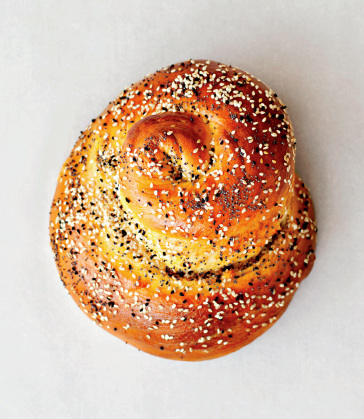
Round Challah
ROUND CHALLAH WITH HONEY BOWL
1 Using one portion of dough, divide the dough into four equal pieces. Roll one piece into a very long, thick strand. Working on a parchment-lined baking sheet, wrap the strand around a 3-inch ovenproof glass bowl. Pinch to close.
2 Roll the remaining dough into 3 equal strands and make a braid following the three-strand directions.
3 Wrap the braid around the dough that surrounds the bowl. Tuck the ends under the challah so the braid appears continuous. Bake with the bowl empty. Fill the bowl with honey before serving.
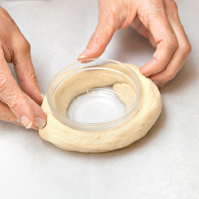
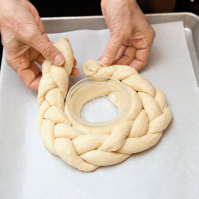
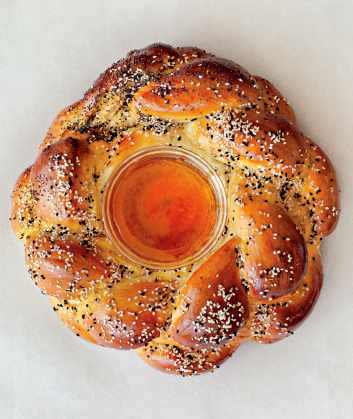
Round Challah with Honey Bowl
VARIATIONS
For earthier-tasting bread: Substitute 1 to 2 cups of whole-wheat flour for the equivalent amount of white whole-wheat flour. You can experiment with different white, whole-wheat, and bread flours to get the texture and flavor you like. NOTE: When using more whole grain or bread flour you will want to increase the salt by ¼ to ½ teaspoon.
For dairy bread: Substitute melted butter for all or part of the oil.
For Rosh Hashanah bread: Before you begin making the dough, place ½ cup raisins in a small bowl with ¼ cup hot water. Let the raisins plump for at least 30 minutes. Add the plumped raisins to the dough before the first rise and shape the dough to make a round loaf. Add 2 teaspoons honey to the glaze for a sweet New Year.
Queen Esther’s Crown Purim Bread

Rabbinic commentators suggest that while Queen Esther (the Jewish heroine of the Book of Esther) lived in the palace of King Ahasuerus in Persia, she ate only seeds, nuts, fruits, and vegetables in an attempt to keep kosher. As a result, many Jews eat seeds and fruits on the holiday of Purim; hence the poppy or fruit-filled hamantaschen tradition at Purim. Another tradition is to make a twisted bread in the shape of a crown. We use our Weekly Challah and fill it with poppy seeds and onions. This recipe is one of our most requested and unusual holiday culinary treats.
MAKES 1 LARGE RING
½ recipe Weekly Challah (here)
Filling
1½ cups very finely chopped yellow onion
6 tablespoons olive oil
½ cup poppy seeds, plus more for sprinkling
½ teaspoon kosher salt
Glaze
1 extra-large egg beaten with 2 tablespoons water
Prepare the challah dough through its first rise of 1 to 2 hours (see here). (NOTE: Do not punch down the dough or knead further.)
Combine the onion, olive oil, seeds, and salt in a small bowl.
Divide the dough portion into two pieces. Using your hands, roll one piece into a 26-inch-long strand. Then, using a rolling pin or your hands, flatten the strand into a 30 x 4-inch rectangle. (If the dough is too elastic to hold the rolled out shape, let it rest for 10 to 15 minutes on the counter and roll it again.)
Spoon half the onion-poppy mixture lengthwise down the center of the dough. Fold one long edge of the dough to just cover the filling. Take the second side of the dough and fold it so that it overlaps the first side by ½ inch. Pinch firmly to seal. Pinch the short ends closed.
Repeat with the second piece of dough.
Arrange the filled strands side by side, seam-side down. Beginning in the middle, cross one strand over the other to form an X-shape, being careful to keep the seams facing down. Starting from the middle cross, continue to cross the strands, one over the other in the same direction, until you reach the end. Pinch the ends together. Repeat with the other end. Coil it into a ring and transfer it to a parchment-lined baking sheet, seam-side down. Tuck one end under the second and pinch to seal tucked end. (NOTE: At this point the ring can be refrigerated up to 24 hours. Remove from the refrigerator and let come to room temperature about 2 hours before baking.)
Preheat the oven to 350°F.
Let the ring rise for about 1 hour in a warm, draft-free place, until doubled in size. Glaze with the egg wash and sprinkle with more seeds, if desired. Bake for 45 to 50 minutes. Rotate the baking sheet in the oven halfway through the baking. The bread should be golden brown and sound hollow when tapped. The internal temperature can be tested with an instant-read thermometer and should be 190°F.
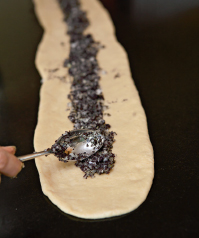
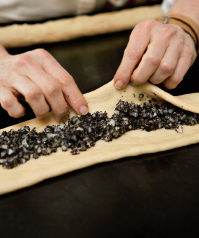
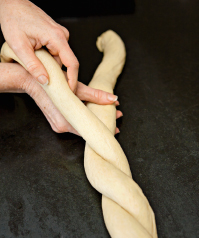
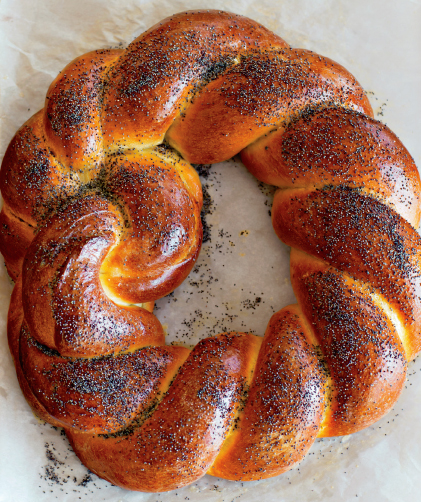
Chocolate Crumb Babka

This is coffee cake par excellence for chocolate lovers. We have taken the same dough that we use to make challah and turned it into another sublime treat. The dough is layered with a chocolate schmear, cinnamon sugar, and chocolate chips to create a rich bread that is perfect for breakfast, brunch, or tea.
The word babka is derived from the Polish word baba, meaning old woman or grandmother. While many people are used to seeing babkas shaped like loaves, they were traditionally round and plump (like our bubbes!). We’ve returned to this shape, primarily because it is how our grandmothers served their babkas. We can still see one of our grandmothers “putting it to her coffee for breakfast” as she used to say.
MAKES 1 LARGE BUNDT BABKA
½ recipe Weekly Challah (here)
Chocolate Schmear
5 ounces bittersweet chocolate (preferably 65% cacao or higher), broken into small pieces
½ cup low-fat milk
8 tablespoons (1 stick) unsalted butter
2 tablespoons cocoa powder
¼ cup sugar
1½ teaspoons pure vanilla extract
Cinnamon Sugar
¼ cup packed brown sugar
2 teaspoons ground cinnamon
Crumb Topping
1 cup unbleached all-purpose flour
8 tablespoons (1 stick) chilled unsalted butter, cut into pieces
½ cup packed brown sugar
1 tablespoon ground cinnamon
1 to 2 teaspoons hot water
Prepare the challah dough through its first rise (see here).
While the dough is rising, prepare the chocolate schmear. In a medium bowl, combine the chocolate pieces, milk, butter cocoa powder, and sugar. Place over a pot with simmering water (or in a double boiler) and melt slowly for about 10 minutes, stirring occasionally. Remove from the heat just before the chocolate has completely melted and stir in the vanilla. Set aside.
To make the cinnamon sugar, combine the brown sugar and cinnamon in a small bowl and set aside.
To make the crumb topping, combine the flour, cold butter, brown sugar, cinnamon, and hot water in the bowl of a food processor fitted with a metal blade. Pulse until the mixture is crumbly. (Or, you can place the ingredients in a bowl and cut the butter into the mixture with two knives.) Transfer the mixture to a bowl and squeeze it with your hands to form crumbly clumps. Set aside.
To make the chocolate drizzle, place the chocolate pieces in a small bowl over a pan with simmering water and, as they begin to melt, add the milk and sugar. Stir, and when the chocolate is completely melted, remove from the heat and set aside. NOTE: This mixture is much thinner than the chocolate schmear.
Grease a Bundt pan with 1 tablespoon softened butter, making sure to fully coat the grooves of the pan. Working on a lightly floured surface or on a piece of parchment paper, divide the dough portion in half. Knead each piece of dough a couple of times. If the dough is very sticky, sprinkle a little bit of flour over it, sparingly. With your hands, roll each piece of dough into a 14-inch-long strand. Cover each strand with a piece of parchment paper and, using a rolling pin, roll the dough into a 14 x 6-inch rectangle. The dough should be very thin, about ⅛ inch thin. Remove the top piece of parchment paper.
Spread half the chocolate schmear onto one piece of the dough, leaving 1 inch from the edges bare. Sprinkle with half the cinnamon sugar and half the chocolate chips if using. Roll the dough up like a jellyroll from a long side. Scrunch the roll and place it in the greased Bundt pan so that it fills only one half of pan—the roll will have an irregular wave shape.
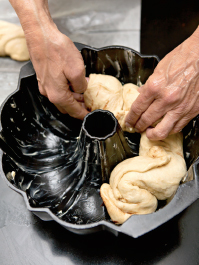
Repeat the process of filling the remaining dough with the chocolate schmear, cinnamon sugar, and chocolate chips. Scrunch the roll and place snugly into the other half of the pan. Pinch the ends together to form a circle. Do not worry if some of the filling is oozing out.
Sprinkle the babka with the crumb topping. If you are using the pecans, sprinkle them over the top. Let it rise for 1½ hours at room temperature or place it in the refrigerator to rise overnight. (If you refrigerate overnight, you will need to remove the babka from the refrigerator and let it come to room temperature for 1 hour before baking.)
Preheat the oven to 350°F. Place the filled Bundt pan on a baking sheet. Bake for 45 to 50 minutes, until the top is golden brown. Remove from the oven and cool in the pan for at least 30 minutes. Loosen from the pan with a blunt knife. Invert the babka onto a plate and then flip it back over to serve. Using a spoon, drizzle it with the chocolate drizzle and serve.
Chocolate Drizzle
2 ounces bittersweet chocolate, broken into small pieces
2 tablespoons low-fat milk
2 tablespoons sugar
1 tablespoon unsalted butter at room temperature to grease pan
1 cup bittersweet chocolate chips or pieces (optional)
½ cup pecans, broken into pieces (optional)